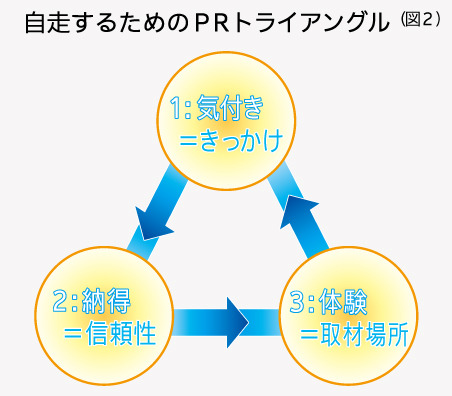Part 2
So, what exactly does strategic PR entail? I'll introduce two solutions we're researching that are both easy to understand and implement. The first is designing information diffusion based on a comprehensive understanding of the information flow structure encompassing media and consumers.
PR activities aim to maximize reach while deepening consumers' interest and understanding of the message, fostering empathy, and ultimately driving purchases and reputation (favorability). The ultimate outcome—moving people to action—is paramount.
Today, the internet has joined the traditional four mass media channels, and social media has also become an indispensable channel when considering the flow of information reaching people. For example, consumer engagement methods have expanded, such as "social viewing," where people simultaneously enjoy TV and social media. Those practicing PR must constantly grasp these new movements and the ever-changing connections between media.
Figure 1 unravels this information distribution structure, centered on the web. We consider two primary pathways for information diffusion. One is the traditional straight news flow: information originating from a source travels through existing electronic media outlets like news organizations to portal sites, then spreads further to television and newspapers. The other involves information originating from sites like "J-CAST News," "Gadget Tsushin," and "Rocket News 24" – known as social media (middle media) – spreading via SNS. This information is then "curated" on aggregation sites like "NAVER Matome" and "Hatena Bookmark" (commonly called Hatena-bu), gaining significant reach. Today, these two channels are closely intertwined; neither can function alone to create a genuine word-of-mouth circle. Among them, middle media has recently gained particular influence. Their style of editing diverse news in an engaging and accessible way from a consumer perspective aligns well with consumer word-of-mouth. They have become popular as a place to find topics for social media posts, attracting significant corporate interest. It is crucial to create and disseminate content that effectively rides this distribution structure—content that goes beyond mere facts and aligns well with the target audience's interests.
Furthermore, gaining traction on these middle media and social networks significantly contributes to achieving the ultimate corporate goal: exposure on television programs. Before greenlighting a segment, TV networks check online buzz and assess the overall level of discussion, such as how extensively it's featured in magazines, to determine whether coverage is warranted. Media outlets use how other media cover a story as part of their decision-making process. I refer to this as "Media to Media" (M2M) information flow. Media outlets never rely solely on primary information; they constantly gauge how society perceives that information and assesses its level of demand.
Alongside understanding the information flow structure, another key theme is the self-sustaining PR Triangle shown in Figure 2. By maximizing the public's conviction in the information disseminated through PR, we can create secondary and tertiary spread where people start talking about it in their own words. How meticulously this initial design is crafted significantly impacts the subsequent natural diffusion potential. This is where I propose the three steps: "Awareness," "Conviction," and "Experience." By sequentially providing these to the target audience, we generate strong empathy and build lasting relationships. "Experience" is particularly crucial. Even with a single piece of word-of-mouth, people naturally speak with much greater conviction about something they've personally experienced. This, in turn, becomes an "Awareness" moment for those around them, creating a three-step cycle that spirals outward, driven by the consumer.

These three steps are actually crucial points for media as well. The blue text in the diagram represents the perspective from the media's viewpoint. First, the "trigger" means clearly defining why the media should cover this information now. Next, ensuring the "credibility" that makes it worthy of mass media coverage. Finally, providing a "location for coverage" where it can be confirmed that this isn't just information, but a real phenomenon occurring. For example, if you can organize an event and create a scene where the general public experiences it and enjoys it, that event itself becomes the location for media coverage.
While media outlets themselves must actively pursue credibility and reporting locations, it's preferable if you can prepare these elements too. Naturally, the final decision on where to report or whether to use the coverage rests with the media—but supporting them in this process is highly welcome.
Furthermore, just as the three steps described earlier spiral outward among your target audience, a similar self-sustaining triangle can emerge among media outlets. When one outlet reports on something, another may recognize its news value and begin considering their own coverage.
Beyond the two approaches illustrated here, considering several recent developments, the shift from "personalizing" to "socializing" the message is what we might call a "boom." Naturally, the optimal strategy varies entirely depending on each case's challenges. Therefore, we plan the most suitable solution neutrally, tailored to the desired outcome, without being confined to publicity tactics alone. This might be the difference between traditional PR and strategic PR. The essence of strategic PR, I believe, lies in utilizing PR not as a single technique, but as a broader concept.
[ Continued in Part 3 ]
[ Back to Part 1 ]






